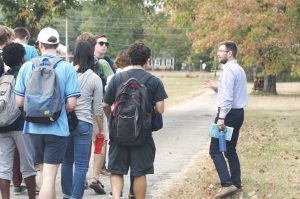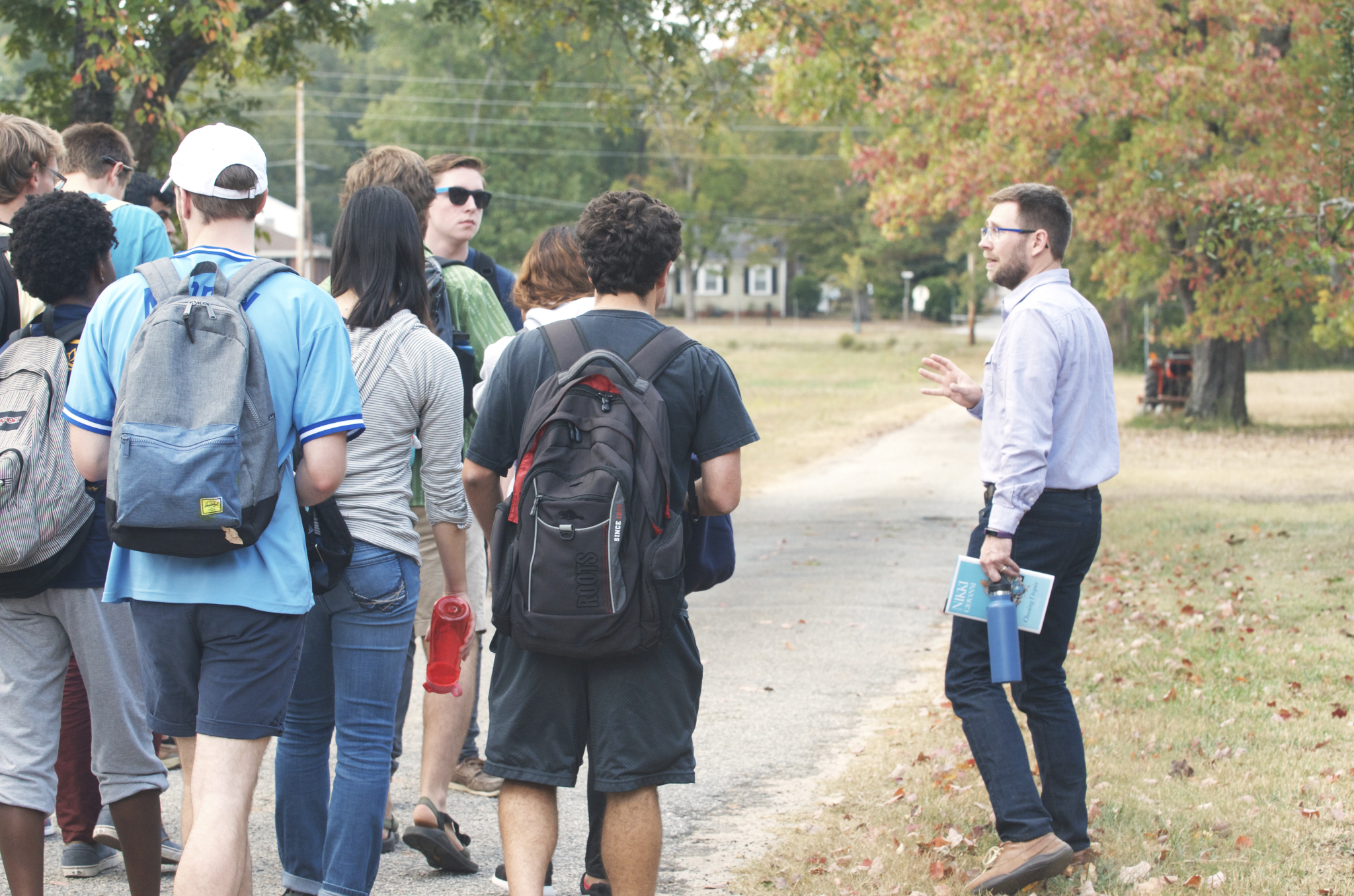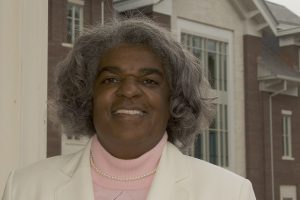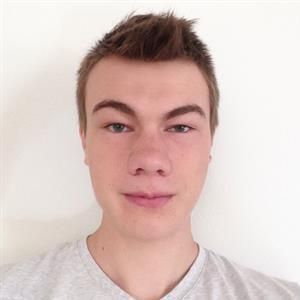
Rev. Lyn Pace and Oxford College students in the class, “Understanding Community,” take a first hand look at the local Oxford community. Photo credit: Claire Asbury Lennox, Candler School of Theology.
The Why & The What of This Project
My doctor of ministry project is about the relationship between colleges and universities, often referred to as town and gown relations. More than this, though, it is about engaging college students in loving God’s world.1 I am a United Methodist minister serving as the college chaplain at Oxford College of Emory University in Oxford, Georgia, a two-year liberal arts college located on Emory’s historic original campus. Working with college students has been a love and passion of mine since early on in my career. In a similar way, I have been passionate about knowing the community in which I live and where my ministry is situated. The Doctor of Ministry program at The Candler School of Theology at Emory University and more specifically the track, “Community Witness and Church Leadership” offered me the opportunity to harness my energy around these interests.
“Understanding Community: Engaging Oxford Students in Loving God’s World” was informed primarily by a class I taught to fifteen first and second year students at Oxford College. Creating opportunities for students and local residents of Oxford, Georgia to be together in relationship with one another and know one another more deeply was made possible by a class such as this.
Bringing together students and local residents was why I chose this project. Students and local residents in Oxford, Georgia were strangers living in each other’s backyard. Except for a class like this, there would likely be no other time or place they would choose to meet. A course would not only help students begin to understand what we mean when we talk about community, but it would be able to require that students put their bodies into the local community in a way that was not happening. The course offered a place where we could talk about our own gifts and assets we bring to the work of building community, and it was also where we could learn how to engage those same gifts and assets with the local residents of Oxford, Georgia in order to make meaning together.
[The video above is of the author, Peter Block, talking about his work on community.2]
The Research Process
The research process for this project began immediately after entering into the doctoral program. It included sitting down with members of the college and local community, which meant that I had to put my body into the community to be with local residents in the same way I would eventually ask students to do.
Early on in an interview with Oxford College’s volunteer programs staff member, I learned that Oxford College students spent the majority of their off-campus volunteer efforts (close to 15,000 hours per year) in activities partnered with non-profits in cities other than Oxford.3 One reason for this was the lack of traditional non-profits in Oxford. The model students had been used to in their volunteer efforts was one that required partnering with an agency. And though they did good work for people, they were rarely able to be with people. So not only was the narrative of the city of Oxford, its residents, and potential connections being missed because of where the students’ work was being done, but the kind of work they were so often doing relied on traditional forms of service delivery that maintained a dependency on professionals.
In the spring of 2015, I selected people to participate in a “mapping team” that consisted of members of the college community and local residents who would have the opportunity to meet with one another four or five times over the course of two to three months. Members included faculty, staff, and students from the college and an equal number of local residents from the community representing a diversity of race, age, and gender. At these meetings, mapping team members, had the opportunity to tell their own life story, share about the gifts they bring to their community, and also talk about their experiences in Oxford. One example of this invaluable research came from mapping team member Sarah Davis as she talked about how she would like to see new ways in which the students and residents (especially “older and lonelier” residents) could interact. She noted that in previous periods of Oxford’s history the connection felt stronger and that people in the local community really do yearn to know the students today.4
This research led me to conclude that there is a gap in the relationship between students at Oxford College and the local residents of Oxford, Georgia. The course I developed was the way I chose to address this problem.
Major Findings/Implications
The course I taught in the fall of 2016, “Understanding Community: Oxford Encountering Oxford,” was designed to engage students in a critical exploration of the concept of community, so they could begin to formulate their own ideas of community, identify various structures of belonging in communities, and develop a more profound understanding of their multiple communities. These communities could include but were not limited to communities of origin, the Oxford campus community, virtual communities, communities of self-interest, intentional communities, and the city of Oxford. A major focus in the course was on the city of Oxford.
Interviews with local residents required students to put their bodies in the community to be in relationship with people they would have never met otherwise. The students met their interviewee at a dinner in late September after we finished the first third of the course, which had prepared them on issues of self-awareness, identity, what it meant to move their body beyond the classroom and into the community and to pay attention to themselves and others more deeply. Then they had about a month to conduct an interview with the local resident. Their assignment required them to transcribe a part of the interview as page one of their paper, and the remainder of the paper was their interpretation of that transcription. Below is an example of one student’s interview.
[The audio recording above is from an interview conducted by Oxford College first year student, Mr. Gabe Eisen with local resident and Oxford alumna, Rev. Avis Williams. Relevant to this doctoral project, you may want to focus on the section that begins at one minute and thirty-nine seconds and ends at seven minutes and thirty-six seconds as well the section that begins at one hour and thirty seconds and concludes at the end of the interview. The audio above & photos below are used with permission from both Mr. Eisen and Rev. Williams.5]
The interviews, though time-intensive, were a significant learning moment and highlight of the course. In a survey administered three times over the semester, I evaluated (among other things) the impact of the interview. In anonymously marking their response to the statement, “Participating in the life of the local Oxford community beyond the campus is not important to my Oxford education,” the most significant movement among students was from “agree” to “disagree” or “neutral” to “disagree.” By the end of the semester, the majority of the class either disagreed or strongly disagreed with the statement, signifying that interactions with local residents were an important part of their education. This was as a direct result of the interviews they completed. In fact, a number of students returned to those same community members to check in with them over the course of the semester as well as for their final projects, which required them to design a project that could be implemented to bridge the town and gown relationship in Oxford.
Prior to teaching the class, I decided to start each class with a contemplative component, a time for students to begin class by putting away all distractions – books, backpacks, food, phones, thoughts (as much as possible) – and to put both feet on the floor for a short time for a contemplative practice. We primarily used silence, anywhere from one to three minutes as a way of centering ourselves and the class collectively. Occasionally we journeyed outside for walking meditations and at other times we used music and poetry.
This meditative moment for students was designed to slow them down from the chaos of their daily lives, and to help them see and listen with greater depth. “Leaders will always be under pressure to speak, but if building social fabric is important, and sustained transformation is the goal, then listening becomes the greater service.”6 By doing this each time we met, a habit was formed that would not only shape them for listening to one another in class but also with the local residents of Oxford. The hope was that it would help them be present in the interviews especially, so that they would pay attention to the reactions of their bodies. Based on the meaningful reflections in their papers about their interview, I believe it worked. At the end of the semester the students specifically commented about the contemplative practices and encouraged me to keep this practice moving forward.
Creating relationships is deeply theological work, but college chaplains serving on a mostly secular campus such as mine have to go about it in more subtle ways. This course was not overtly religious, and that was by design. I taught the course as an interdisciplinary course in American studies and assigned readings that were not religious or theological. That said, the course was informed by my theology and thus intentionally designed to help students engage their values and subsequent reflection on those values. In the students’ final course evaluations issued by the college, all fifteen students said they made either “substantial progress” or “exceptional progress” in “Developing a clearer understanding of, and commitment to, personal values.”7
What’s Ahead?
Bringing together students and local residents in an effort to bridge the gap in town and gown relationships is not something that will happen overnight. It could take even longer to see substantive changes in how students perceive the communities in which they live and work and how their civic engagement has been affected because of this course. Because our campus is only for first and second year students, I may not have the privilege of being up-to-date on these results, but to know that God has already been active in their midst is important so as not to presume to be the first or last person offering them knowledge and/or skills for understanding community. And yet, it is essential to understand, especially as part of a meaning-making liberal arts education, that as a representative of God and the church, I have a responsibility to engage them in loving the world. While there were some tangible results from the course, particularly in the interviews with local residents as well as the research, I fully expect other learning outcomes to be realized over time.
The course (originally taught as a “special topics” course) has already been submitted and approved as a permanent course in the college curriculum, and I hope to teach it at least every other year (currently slated for Fall 2018). This offers the opportunity to improve the course based on my own observations and reflections of teaching. Already-established relationships in the community as well as positive responses from those who participated in the first iteration of the course means that having even more community members participate in the future is a reality. This will allow for the interview portion of the course to continue. City council members have approached me about having the students in a future course think through strategic ways of engaging segments of the city that are currently disengaged. This kind of opportunity is exciting and daunting, but it will allow for the kind of first-hand experiences that can be transformative for the students and their teacher. Not only will students have the opportunity to be in relationship with people they would not have been otherwise, but the possibilities for making meaning and doing justice related work are real.
Finally, it is hoped that this project will not only be helpful to college chaplains but also local churches. In our local churches we too often overlook the communities in which we are situated. We miss the opportunity for creating relationships and learning about the gifts and assets in the people of our communities. God’s being with humanity through the person of Jesus Christ enables humanity to participate in divinity. The ministry of Jesus Christ on which the church is built was forever about being with people. Jesus’s life and ministry was about putting his own body in relationship with others in the communities to which he traveled and took up residence. He reached across difference to be with people who, in the culture in which he lived, were considered vulnerable, unclean, and unwell. We are called to be in relationship with all people, and that is what I have tried to demonstrate in this project.
Why Does This Matter?
Students rarely choose a college or university based on getting to know the local residents in the community in which the college or university is situated. But that does not mean colleges and universities should not be finding ways to bring these two groups together. It is the same for the local church.
My vocation as a minister of the gospel is to uncover the ongoing work of God in the world. My work is to assist in revealing the very nature of God, which is to be present with one another and in relationship with one another despite differences. The gospel draws us into community in and with the world where we must engage difference. This is more than simply taking care of one’s own congregation, which often happens, of course. Ministers are expected by those in their congregation or on their campus to take care of them and do things for them, but as a minister of the gospel of Jesus Christ I am responsible for moving students’ bodies into the community and across difference to be with local residents where they begin to understand that their work is about loving the world. This work is about helping them know that more than one story exists about a person or a community.
[I used the above video, “The Danger of a Single Story,” during the first third of my course. After the students completed a writing assignment associated with the video as well as a discussion about it in class, it became a formative reference point for students throughout the remainder of the course.8]
This project matters because our capacity for knowing more than one story and how to be present with one another and listen deeply to one another has waned. This project addressed this, which is why the contemplative component mentioned above was an instrumental part of the course. This also matters because civic engagement among individuals and in local communities in the United States has been trending downward for decades. As he points out in his monumental research on the subject, Robert Putnam suggests that social capital in almost all its forms increased substantially between 1947 and 1965 and decreased substantially between 1965 and 1998.9 Re-learning how to be still, listen, and be present is essential to this work. My hope is that this course is a model for ways to engage students, congregations, human beings in this kind of work. To engage in the work of loving God’s world will require a shift in the dominant narrative, but it is worth it.
Notes
1. “Loving the world” is a phrase that is inspired by and taken from Mary Oliver’s poem, “Messenger.” Mary Oliver, Thirst: Poems by Mary Oliver (Boston: Beacon Press, 2006), 1.
2. “Peter Block on Building Communities,” Peter Block, https://www.youtube.com/watch?v=qcADGhovJuM.
3. Kasey Robinson Harvill, interview by author, recorded in notes, Oxford, Georgia, November 10, 2014. .
4. Sarah Davis, interview by author, recorded in notes, Oxford, Georgia, April 7, 2015.
5. Avis Williams, interview by Gabe Eisen, Oxford, Georgia, September 30, 2016.
6. Peter Block, Community: The Structure of Belonging (San Francisco: Berrett-Koehler Publishers, Inc., 2008), 88.
7. This data, to which I have access, is from an IDEA survey administered to students on the final day of the course, December 6, 2016.
8. “The Danger of a Single Story,” Chimamanda Ngozi Adichie, https://www.youtube.com/watch?v=D9Ihs241zeg.
9. Robert Putnam, Bowling Alone: The Collapse and Revival of American Community (New York: Simon & Schuster Paperbacks, 2000), 281.
Save
Save


